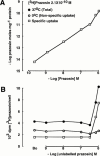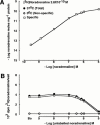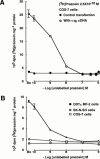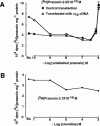alpha(1B) adrenergic receptors in gonadotrophin-releasing hormone neurones: relation to Transport-P
- PMID: 11156594
- PMCID: PMC1572539
- DOI: 10.1038/sj.bjp.0703781
alpha(1B) adrenergic receptors in gonadotrophin-releasing hormone neurones: relation to Transport-P
Abstract
1. Peptidergic neurones accumulate amines via an unusual uptake process, designated Transport-P. [(3)H]-prazosin binds to alpha(1) adrenoceptors on these cells and is displaceable by unlabelled prazosin in concentrations up to 10(-7) M. However, at greater concentrations of prazosin, there is a paradoxical accumulation of [(3)H]-prazosin which we have attributed to Transport-P. Uptake of prazosin via Transport-P is detectable at 10(-10) M prazosin concentration, is linear up to 10(-7) M and at greater concentrations becomes non-linear. In contrast, in noradrenergic neurones, noradrenaline uptake is linear and saturates above 10(-7) M. In noradrenergic neurones and in non-neuronal cells, there is no uptake of prazosin in concentrations up to 10(-6) M, suggesting that Transport-P is a specialised function of peptidergic neurones. 2. Using a mouse peptidergic (gonadotrophin-releasing hormone, GnRH) neuronal cell line which possesses Transport-P, we have studied the interaction of alpha(1) adrenoceptors with Transport-P. Polymerase chain reactions and DNA sequencing of the products demonstrated that only the alpha(1B) sub-type of adrenoceptors is present in GnRH cells. 3. In COS cells transfected with alpha(1b) adrenoceptor cDNA and in DDT(1) MF-2 cells which express native alpha(1B) adrenoceptors, [(3)H]-prazosin was displaced by unlabelled prazosin in a normal equilibrium process, with no prazosin paradox in concentrations up to 10(-6) M. In DDT(1) MF-2 cells, [(3)H]-prazosin was displaced likewise by a series of alpha(1) adrenergic agonists, none of which increased the binding of [(3)H]-prazosin. Hence, the prazosin paradox is not due to some function of alpha(1) adrenoceptors, such as internalization of ligand-receptor complexes. 4. In neurones which possess Transport-P, transfection with alpha(1b) adrenoceptor cDNA resulted in over-expression of alpha(1B) adrenoceptors, but the prazosin paradox was unaltered. Thus, alpha(1) adrenoceptors and Transport-P mediate distinct functions in peptidergic neurones.
Figures





Similar articles
-
Functional properties of the uptake of amines in immortalised peptidergic neurones (transport-P).Br J Pharmacol. 1996 Jan;117(1):111-8. doi: 10.1111/j.1476-5381.1996.tb15162.x. Br J Pharmacol. 1996. PMID: 8825351 Free PMC article.
-
High-affinity uptake of noradrenaline in postsynaptic neurones.Br J Pharmacol. 1993 Jun;109(2):299-307. doi: 10.1111/j.1476-5381.1993.tb13570.x. Br J Pharmacol. 1993. PMID: 8358534 Free PMC article.
-
Sympathetic neurotransmission in the rat testicular capsule: functional characterization and identification of mRNA encoding alpha1-adrenoceptor subtypes.Eur J Pharmacol. 2006 Aug 14;543(1-3):141-50. doi: 10.1016/j.ejphar.2006.05.045. Epub 2006 Jun 2. Eur J Pharmacol. 2006. PMID: 16822496
-
The mechanism of action of antidepressants: a unitary hypothesis based on transport-p.Curr Drug Targets CNS Neurol Disord. 2004 Jun;3(3):201-16. doi: 10.2174/1568007043337562. Curr Drug Targets CNS Neurol Disord. 2004. PMID: 15180481 Review.
-
Molecular mechanisms underlying the activation and regulation of the alpha 1B-adrenergic receptor.Biochem Soc Trans. 1996 Nov;24(4):959-63. doi: 10.1042/bst0240959. Biochem Soc Trans. 1996. PMID: 8968492 Review. No abstract available.
Cited by
-
Release of amines from acidified stores following accumulation by Transport-P.Br J Pharmacol. 2001 Feb;132(4):851-60. doi: 10.1038/sj.bjp.0703872. Br J Pharmacol. 2001. PMID: 11181426 Free PMC article.
-
The cytotoxicity of the α1-adrenoceptor antagonist prazosin is linked to an endocytotic mechanism equivalent to transport-P.Toxicology. 2015 Dec 2;338:17-29. doi: 10.1016/j.tox.2015.09.008. Epub 2015 Oct 9. Toxicology. 2015. PMID: 26449523 Free PMC article.
-
The relationship between pulsatile GnRH secretion and cAMP production in immortalized GnRH neurons.Am J Physiol Endocrinol Metab. 2011 Jun;300(6):E1022-30. doi: 10.1152/ajpendo.00081.2011. Epub 2011 Mar 29. Am J Physiol Endocrinol Metab. 2011. PMID: 21447787 Free PMC article.
References
-
- AL-DAMLUJI S.Adrenergic control of the secretion of anterior pituitary hormones Bailliere's Clinical Endocrinology and Metabolism 7 1993355–392.(part 2) - PubMed
-
- AL-DAMLUJI S., KRSMANOVIC L.High-affinity uptake of noradrenaline by GnRH cells Abstr. Endo. Soc. 199274197(abstract)
MeSH terms
Substances
LinkOut - more resources
Full Text Sources
Other Literature Sources
Miscellaneous

